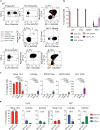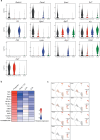Recipient tissue microenvironment determines developmental path of intestinal innate lymphoid progenitors
- PMID: 39242588
- PMCID: PMC11379955
- DOI: 10.1038/s41467-024-52155-2
Recipient tissue microenvironment determines developmental path of intestinal innate lymphoid progenitors
Abstract
Innate lymphoid cells (ILCs) are critical in maintaining tissue homeostasis, and during infection and inflammation. Here we identify, by using combinatorial reporter mice, a rare ILC progenitor (ILCP) population, resident to the small intestinal lamina propria (siLP) in adult mice. Transfer of siLP-ILCP into recipients generates group 1 ILCs (including ILC1 and NK cells), ILC2s and ILC3s within the intestinal microenvironment, but almost exclusively group 1 ILCs in the liver, lung and spleen. Single cell gene expression analysis and high dimensional spectral cytometry analysis of the siLP-ILCPs and ILC progeny indicate that the phenotype of the group 1 ILC progeny is also influenced by the tissue microenvironment. Thus, a local pool of siLP-ILCP can contribute to pan-ILC generation in the intestinal microenvironment but has more restricted potential in other tissues, with a greater propensity than bone marrow-derived ILCPs to favour ILC1 and ILC3 production. Therefore, ILCP potential is influenced by both tissue of origin and the microenvironment during development. This may provide additional flexibility during the tuning of immune reactions.
© 2024. The Author(s).
Conflict of interest statement
The authors declare no competing interests.
Figures









References
Publication types
MeSH terms
Associated data
- Actions
- Actions
Grants and funding
- 100963/Z/13/Z/Wellcome Trust (Wellcome)
- U105178805/RCUK | Medical Research Council (MRC)
- WT_/Wellcome Trust/United Kingdom
- 220223/Z/20/Z/Wellcome Trust (Wellcome)
- 896454/EC | EU Framework Programme for Research and Innovation H2020 | H2020 Priority Excellent Science | H2020 Marie Skłodowska-Curie Actions (H2020 Excellent Science - Marie Skłodowska-Curie Actions)
LinkOut - more resources
Full Text Sources
Molecular Biology Databases

